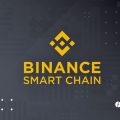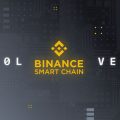
The Solidity programming language designed forthe development of smart contracts on the blockchain, has become the standard for the crypto industry. It is in this language that the smart contract of the largest network for decentralized applications, Ethereum, was written.
Solidity allows you to create smart contracts,possessing Turing completeness, that is, capable of working autonomously without the participation of a third party. The language became the basis for the creation of Tendermint – one of the most advanced consensus mechanisms based on the Byzantine Fault Tolerance (BFT) problem, on whichthe Cosmos blockchain network works. In this overview, we'll cover the major platforms that support the Solidity language.
Ethereum
The Solidity language was developed by the project team,which created the blockchain platform on it. Now the Ethereum network is the world's leading among projects running on smart contracts. The platform was created in 2014, and its creator was Vitalik Buterin – one of the most influential people in the crypto industry.
Ethereum provides an ecosystem for developmentstandalone decentralized applications (DApps) and the largest DeFi protocols such as Uniswap, MakerDAO, Compound, Aave and many others were created on its basis. In fact, this is not an advantage for Ethereum, since the more applications use it, the more the network will be loaded.
The rapid rise in popularity of DeFi is evident in thisdemonstrated: due to high user activity, the cost of transactions reached unprecedented heights, and sometimes commissions exceeded $ 100 per transaction.
The platform is supported by a huge community,which was formed over 7 years of the existence of the cryptocurrency. Despite this popularity, the Ether network suffers from scalability issues, resulting in slow and costly transactions.
While the developers are trying to solve the problem,working on the Ethereum 2.0 update. The updated platform will fully function on the Proof-of-Stake (PoS) consensus algorithm, and the protocol will be based on the deflationary mechanism that appeared on the network after the London hard fork. This means that part of the coins paid for Gas will be irrevocably burned, and the emission of ETH – decrease accordingly.
Ethereum classic
Few people know, but it is Ethereum Classic– This is the original Ethereum blockchain, which “split off” after a hard fork that resulted from the hacking of the infamous The DAO project, and ETC coins became ERC-20 tokens. This had to be done in order to restore the lost funds, while the main blockchain continued to function as a fork.
Ethereum Classic runs on an algorithmProof-of-Work, just like Ethereum nowadays. The proponents of the original network are keen to keep the protocol intact and are not going to change it, which is the main disadvantage of the platform. The fact is that the initial version of the blockchain limits the emission of cryptocurrencies to 210 million ETC, while the emission of ETH will only decrease over time.
Despite the disadvantages, the Ethereum Classic tokenis ranked 19th in the CoinMarketCap ranking in terms of capitalization, which indicates strong community support. But the outdated PoW mechanics and lack of scalability in the long term will not give the platform any advantages.
Polkadot
This platform uses the Solidity language toproviding the functionality of a smart contract. The Polkadot ecosystem links multiple blockchains into one network, making the platform scalable. These blockchains in the project network are called parachains. They not only increase the network bandwidth, but can also interact with each other. This property is known as interoperability or, in other words, compatibility.
The Polkadot network is segmented and the parachains are notare isolated, unlike other blockchain networks such as Bitcoin or Ethereum. They can process transactions in parallel to each other, and if one of the networks is overloaded, then users can use the other parachain to make transactions.
In addition, this approach to architecture allowsoptimize individual blockchains for specific tasks, such as identity management or data storage. Decentralized applications built on the basis of Polkadot will also be able to interact with each other. Polkadot is considered one of the main competitors to Ethereum and other similar networks.
Binance Smart Chain
All projects and tokens based on the ecosystemBinance Smart Chain (BSC) uses smart contracts created using the Solidity language. Binance Coin (BNB), Binance USD (BUSD), PancakeSwap (CAKE), Venus (XVS) and other BEP-20 tokens use Solidity to create a smart contract.
BSC – the second most popular decentralized application ecosystem after Ethereum. The BSC network has better throughput, and transactions are faster and cheaper.
Binance Coin (BNB) was originally created asERC-20 token issued based on Ethereum. Later, Binance developers improved the smart contract and launched their own BSC main network, where BNB tokens migrated and after which they became cryptocurrency. Then came the Binance Smart Chain, which became an improved version of Binance Chain. Despite the higher throughput compared to Ethereum, the BSC network has the same disadvantages that have become more noticeable as its popularity has grown: with high load, transactions become slower and more expensive.

Tron
Another large network of decentralizedapps and the largest blockchain gaming platform. Tron specializes in the entertainment industry, offering users decentralized games, marketplaces and token exchanges.
Tron architecture is based on distributedEthereum registry. The platform was created in 2017 by Justin Sun, who became the head of the non-profit Tron Foundation. Developers use the Solidity language to create decentralized applications that are part of the Tron ecosystem.
The project has been repeatedly accused ofcopied the Ethereum architecture without introducing practically nothing new. But like the Binance Smart Chain, the Tron network has improved scalability, allowing users to make fast and cheap transactions. Also, unlike Ethereum, the throne is based on a PoS consensus mechanism.
In fact, holders can committransactions are free by freezing TRX coins to generate power to power the platform. Apart from its narrow focus on the media industry, the Tron blockchain does not have any outstanding features that strongly distinguish it from its competitors.
Uniswap
Uniswap – DeFi protocol created forexchanging ERC-20 tokens and providing liquidity (yield farming) and based on the Ethereum platform. The platform functions as an automated market maker (AMM) with the functionality of a decentralized exchange (DEX).
Unlike centralized crypto exchanges, Uniswapdoes not depend on an intermediary, and liquidity providers provide liquidity to the decentralized platform. This allows users to simultaneously securely exchange digital tokens on the exchange and receive income from liquidity mining by adding tokens to pools.
The main problem with Uniswap is that the platformdepends on the Ethereum ecosystem. This means that it will face the same problems as the main blockchain. And the greater the demand for the platform, the more scaling problems will manifest themselves, which will force users to look for alternative platforms. This happened with Binance Smart Chain: due to high fees, many users switched to the BSC network, which, in turn, also led to scalability problems.
Zhcash
Zhcash platform is based on a hybrid approach,providing the flexibility of Ethereum-based smart contracts. Zhcash integrates blockchains and Ethereum virtual machines (EVMs) to create flexible and efficient decentralized applications.
Zcash team introduced tools for fastdeveloping our own smart contracts, DApps and issuing Ethereum-based tokens. This allows you to quickly launch efficient applications with minimal programming skills in the Solidity language.
Zchash – This is a fork of Bitcoin with an Eth virtual machine. In other words, the developers have extracted the best properties of both protocols to create an innovative blockchain network.
The decentralized platform uses a combination of three consensus algorithms at once:
- PoS V3 — This is a new concept of Proof-of-Stake. Thanks to it, every wallet in the Zcash network becomes a full-fledged node that can participate in staking at the same level as validators.
- IPoS – a unique mechanism developed by the Zhcash team. Token holders can delegate coins to supernodes.
- DPoS – algorithm that divides the network intovalidators and delegators. Most modern blockchains, such as Solana, Cosmos, Tezos and many others, are built on this consensus mechanism.
The peculiarity of Zhcash is that the network does not useblockchain Ethereum, but is a separate full-fledged blockchain. Possessing sovereignty, the Zhcash platform does not depend on the restrictions of bitcoin or ether, which allows it to add new, improved functionality.

Avalanche
Avalanche – open decentralizedplatform for creating blockchain networks and applications based on Ethereum, created by Ava Labs. The Avalanche platform aims to displace Ethereum as the main network for running decentralized applications.
Developers have created their own DeFi ecosystem.This caught the attention of crypto enthusiasts, making AVAX one of the fastest growing tokens in 2020. Well-known crypto projects such as bZx, Reef, SushiSwap and TrueUSD have integrated their solutions with the Avalanche platform.
The core of the project architecture is the subnet(subnetwork), also called Primary Network, which is a group of validators that secure the entire network, confirm transactions and add blocks.
The Primary Network consists of three blockchains:
- X-Chain – platform for issuing and trading crypto assets (tokens).
- P-Chain – which coordinates the work of validators, allows you to create new subnets and custom blockchains.
- C-Chain – simplifying the creation of smart contracts.
The developers presented their own virtualthe Avalanche Virtual Machine (AVM) and a Proof-of-Stake consensus algorithm called Snowball. The main difference from classic PoS is that Snowball completely cancels rewards if validators behave in a malicious manner, rather than trimming them. While the concept seems interesting, blockchain experts are not convinced that Avalanche poses a serious threat to Ethereum.
Hedera hashgraph
The peculiarity of Hedera Hashgraph is that the networkbuilt entirely from scratch and does not use the technology of existing decentralized projects that are part of the global DeFi ecosystem. It is noteworthy that the developers use the Solidity language: this speaks of the broad functionality of this programming language for the development of advanced blockchain networks.
Instead of complex and time-consuming mining, the platformHedera Hashgraph offers a different algorithm – directed acyclic graph (Directed Acyclic Graph or DAG). Hedera Hashgraph – not a blockchain in the usual sense of the word. The Hedera Hashgraph network can rather be thought of as a tree of graphs.
This structure is remarkable in that the speedtransactions increases as new transactions are added to the network. In other words, transactions on the network are processed and confirmed in parallel, rather than sequentially, as in Bitcoin or ether networks. Developers aim to achieve throughput in excess of 100,000 transactions per second with minimal computational costs.
The project team are using the same language asthe creators of Ethereum, to develop a smart contract. Smart contracts on the Hedera Hashgraph network are needed so that users can create their own DApp applications on top of the network used for various purposes: games, DeFi platforms, digital identity and much more.
But Hedera Hashgraph has one essentialdisadvantage: unlike most projects, the platform contains closed source code, which complicates the audit and does not allow revealing the intention of the founders. In addition, the creators of the project have patented the technology, so that independent developers will not be able to create forks to improve the operation of the protocol.
Conclusion
There are few platforms using the languageSolidity for architecture and smart contracts. However, during its existence, this programming language has become the standard for the blockchain industry. After all, many leading platforms, such as Ethereum, Binance Smart Chain, Polkadot and others, are built on Solidity. However, most of the developers of these platforms do not seek to go their own way, but are trying to remove the leader, taking his place of honor in the DeFi ecosystem.
Instead of just competing withEthereum, Zhcash developers have created a unique concept using the most efficient properties of blockchains. Zhcash uses a hybrid model for blockchain operation, which allows validators and standard nodes to easily and quickly switch between consensus algorithms for the most efficient interaction.
You can buy ZHCASH, ETH, BTC and other cryptocurrencies here





